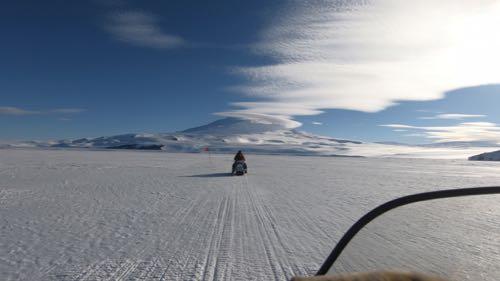Today marks 50 days since I left the Ice. Though I am glad to be home and was able to enjoy the holiday season with my friends and family I definitely miss working in Antarctica. This journal entry describes my typical day in the field. Thank you for following.
I was always exhausted and I loved it. My alarm clock would go off at 06:00 and I would check the weather while getting ready. Our team along with others would meet in the galley for breakfast. If it was a field day, which it usually was, we made sure to consume protein, mostly eggs. After we went to our laboratory in Crary If needed I would get the PistenBully running then start on boiling water to take with us in the field. Other team members would be double-checking equipment, filling paperwork, communicating with other departments on base. With usually about 15 minutes until departure, everyone would start getting dressed. We would check the checklist for supplies we needed before we walked out of the door. Sunscreen and radios were the most forgotten items. We would load the equipment, count survival bags, if taking the PistenBully it was close, if taking the snowmobiles we would have to sign out the truck to take down equipment. If taking snowmobiles, double-check that all the equipment was properly tied down, start the machines, check that no one had any skin exposed.
No matter what form of transportation it was time to check out with MacOps. It was impossible not to mentally lose yourself on the commute. The trek to our field sites was so vast, every day it amazed each of us we were driving on the Ross Sea iceThere are terms for different types of ice. Shorefast ice forms along coasts and is attached to land. Pack ice is ice floating in open water. Multiyear ice is ice that has survived at least 1 summer. First year ice is ice that has not yet survived a melting season., below us was the ocean. It was beautiful. The days the light was flat reminded us of that the road we were traveling still had its dangers. We could not see the texture of the ice as we were traveling, it was easier to stay in the tracks of previous travelers those days, trusting that they made the journey safely and you would as well.

As we reached our field sites our bodies’ muscle memories took over, without thinking preparing for the tasks that we needed to complete that day. Setting out the proper equipment to work with the pups, preparing the sled, radio checks, scouting for that day’s pup and checking on others in the study, taking respiratory videos and molting data if time allowed. If it was a metabolic day we would set up the chamber, start the generator, set up the computer equipment and gas meters, drill a hole in the sea ice and put up flags to clearly mark the hole. Before we collected the pup for the day checking in on everyone to make sure all were physically and mentally prepared, need a snack/ lunch, what about a pee break. When everyone was prepared to march out as a team, sled, net, herding boards, thermal camera, GoPros, radios. I don’t know this became my norm, but it did I knew exactly what to do. We were so smooth at our jobs.

Sometimes it was my job to watch mom, she usually used her time to take a nap, but a few would pace back and forth looking for their pup, before settling down. We were equipped with a board, about 3 feet by 2 feet, to herd this 1300 pound, mother, but as I became comfortable with these giants I learned that this piece of wood was more than enough. The mothers were not aggressive.
Other times I would be on data collection, this job very important, you are responsible for keeping everyone on a specific time schedule for sample collection and recording numbers from multiple people because we work as efficiently as possible. Sometimes I was the one yelling out numbers girth, length, weight, heart rate, respiratory rate, just to name a few.
We rotated through the roles, more frequently on days when the weather was intense. Dressing in layers to protect ourselves from the cold temperatures was possible the high winds were the real enemy, days where your MICROspikes were not stopping you from being blown across the ice.

After the pup was rejoined with their mom, the veterinarians would observe the reunion for thirty minutes. In that amount of time, the team would fully pack up equipment and take care of our bodies’ needs. Within forty-five minutes we would be on our journey back to McMurdo Station, back to the “rock”, as we would say when checking back in with Mac Ops.

Our day was far from over, first, we had to fuel our vehicles then it was time to change out of our gear, organize and analyze samples, cleanup equipment, properly dispose of waste, and prepare for the next day. This would take at least an hour or more. Then we would go to the galley to refuel our bodies. You may think with our exhaustion we would sit in silence and eat, but we were always laughing and enjoying each others’ company. Then we would head back to the dorms, take a well-deserved warm shower and get some rest.


Comments